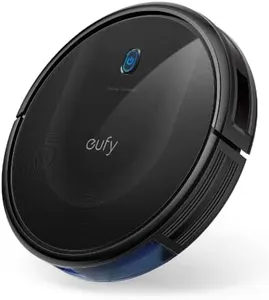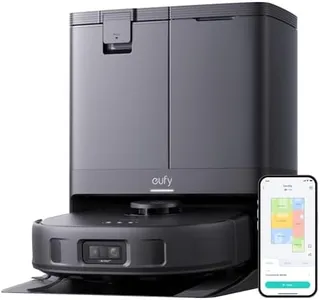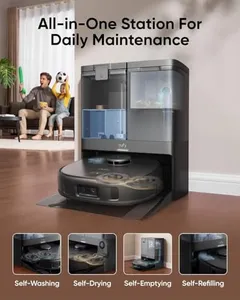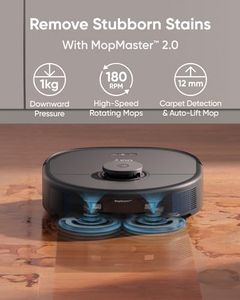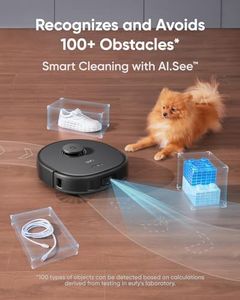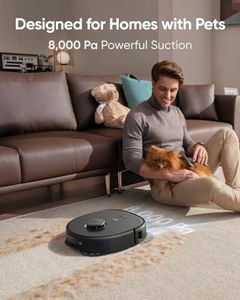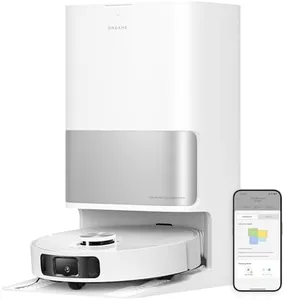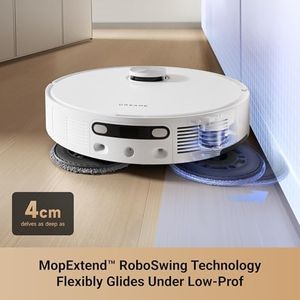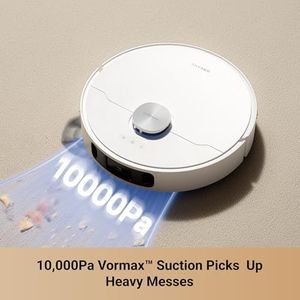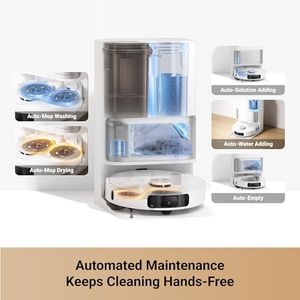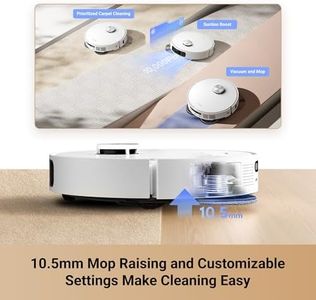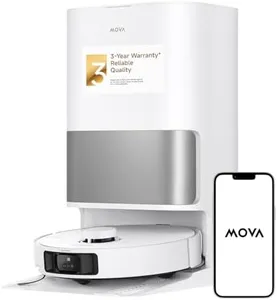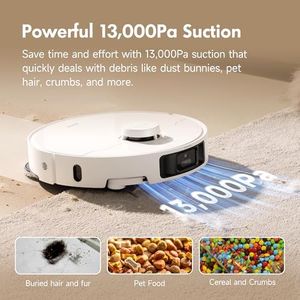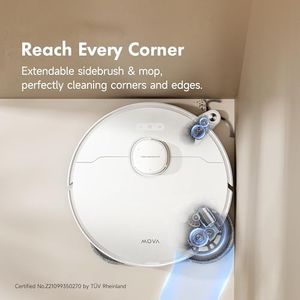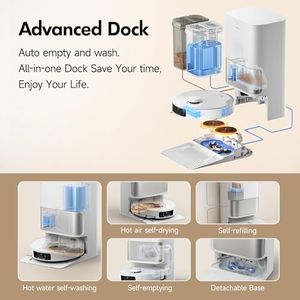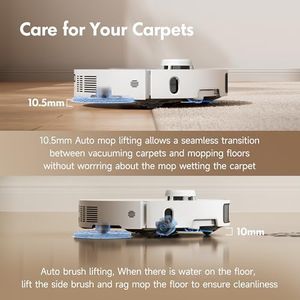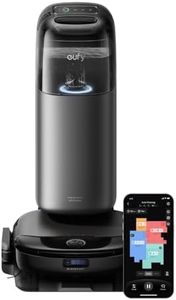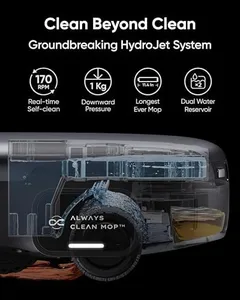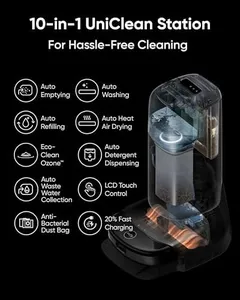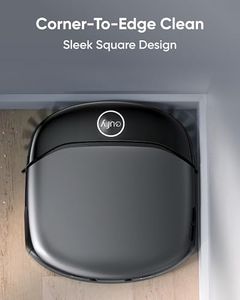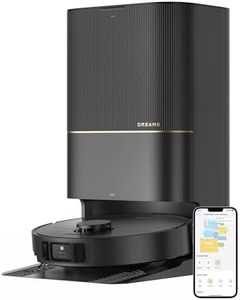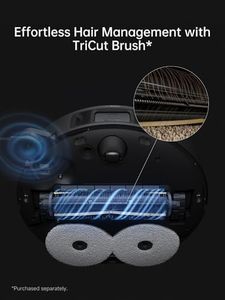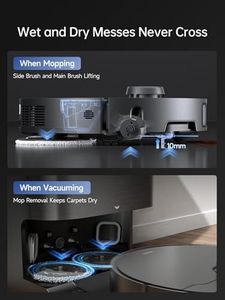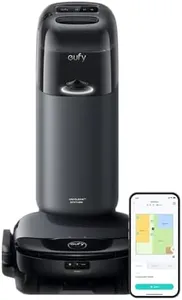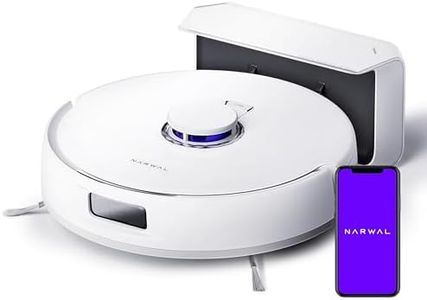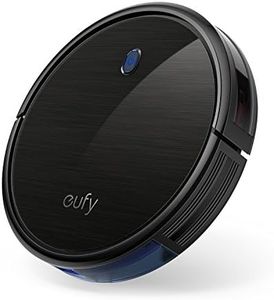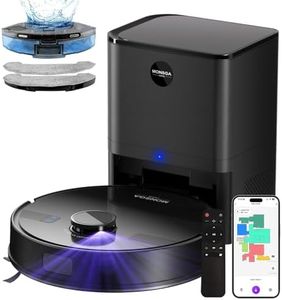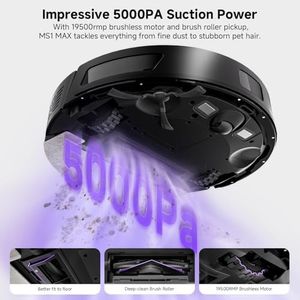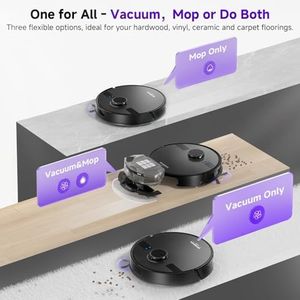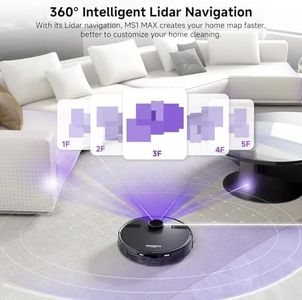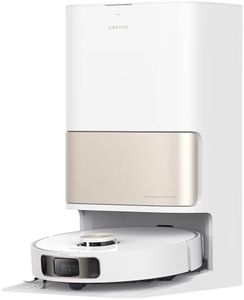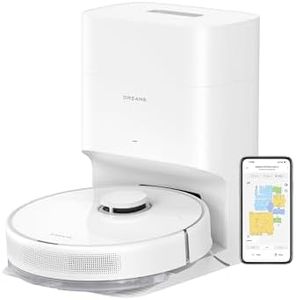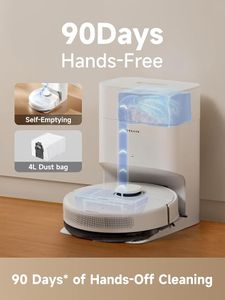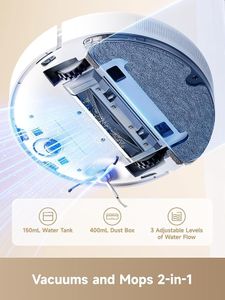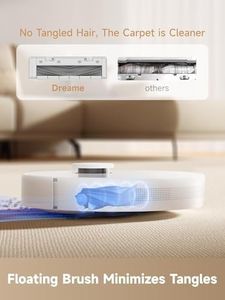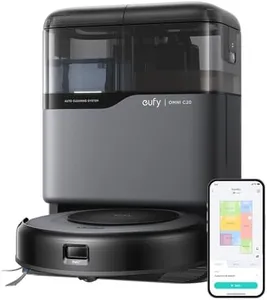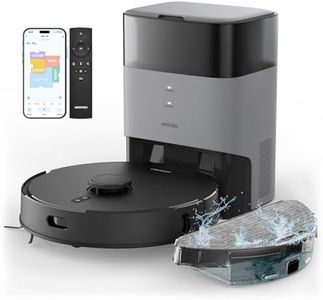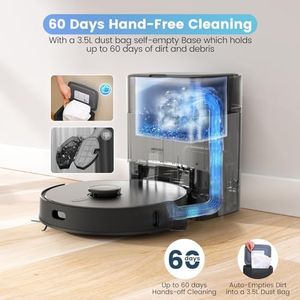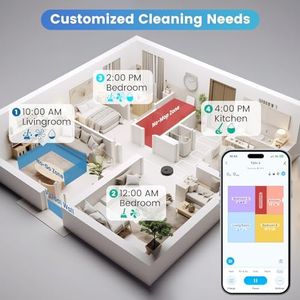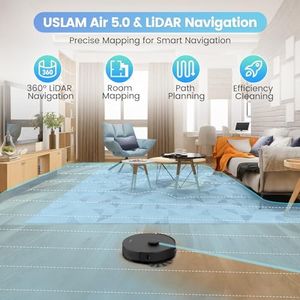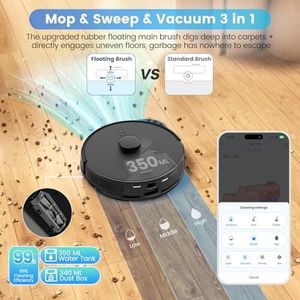We Use CookiesWe use cookies to enhance the security, performance,
functionality and for analytical and promotional activities. By continuing to browse this site you
are agreeing to our privacy policy
10 Best Vacuum Robots
From leading brands and best sellers available on the web.Top 10 Best Vacuum Robots 2025 in Canada
#1
Winner
eufy X10 Pro Omni Robot Vacuum and Mop with 8,000 Pa Suction, Dual Mops with 12 mm Auto-Lift and Carpet Detection, AI Obstacle Avoidance, Auto Mop Washing & Drying, Self-Emptying, Self-Refilling
eufy X10 Pro Omni Robot Vacuum and Mop with 8,000 Pa Suction, Dual Mops with 12 mm Auto-Lift and Carpet Detection, AI Obstacle Avoidance, Auto Mop Washing & Drying, Self-Emptying, Self-Refilling
Suction Power: 8,000 Pa
Navigation System: Laser system with AI
Battery Life: 173 minutes
Dustbin Capacity: 2.5L bag
Floor Type Compatibility: Hard Floor, Carpet, Wood, Tile
Smart Features and App Control: App, Button, Voice control, No-go zones
Maintenance and Filter Type: Washable filter, Auto mop wash/dry, Self-empty
Chosen by 1303 this week
dreame L10s Ultra Gen 2 Robot Vacuum and Mop, 10,000Pa Suction, MopExtend Technology, All-in-One Base Station, Pet-Friendly, Versatile Carpet Cleaning, DuoScrub Mopping System, Smart Pathfinder Tech
dreame L10s Ultra Gen 2 Robot Vacuum and Mop, 10,000Pa Suction, MopExtend Technology, All-in-One Base Station, Pet-Friendly, Versatile Carpet Cleaning, DuoScrub Mopping System, Smart Pathfinder Tech
Suction Power: 10,000 Pa
Navigation System: Smart Pathfinder, 3D mapping
Battery Life: 240 minutes
Dustbin Capacity: 300mL vacuum, 3.2L base
Floor Type Compatibility: Wood, Tile, Rugs
Smart Features and App Control: App, voice, remote control
Noise Level: Under 42dB drying
Maintenance and Filter Type: Cloth filter, auto detergent refill
MOVA P10 Pro Ultra Robot Vacuum and Mop 13,000Pa Suction, 140°F Hot Water Auto Mop Washing & Drying, Dual Spinning Extenable Mop,10.5mm Lifting for Carpet, 360°Obstacle Avoidance, App Control
MOVA P10 Pro Ultra Robot Vacuum and Mop 13,000Pa Suction, 140°F Hot Water Auto Mop Washing & Drying, Dual Spinning Extenable Mop,10.5mm Lifting for Carpet, 360°Obstacle Avoidance, App Control
Suction Power: 13,000Pa
Navigation System: RGB camera, 3D light, LED
Battery Life: 2.5 hours
Dustbin Capacity: 3.2L dust bag
Floor Type Compatibility: Hard Floor, Tile, Marble, Carpet
Smart Features and App Control: App, Voice, Button control, schedules
Noise Level: Low
Maintenance and Filter Type: HEPA filter, cleaning tools
eufy Robot Vacuum Omni S1 Pro with All-in-One Station, HydroJet Robot Vacuum and Mop, 8000 Pa Suction, Obstacle Avoidance, Auto Mop Washing & Drying, Self-Emptying
eufy Robot Vacuum Omni S1 Pro with All-in-One Station, HydroJet Robot Vacuum and Mop, 8000 Pa Suction, Obstacle Avoidance, Auto Mop Washing & Drying, Self-Emptying
Suction Power: 8,000 Pa
Navigation System: 3D MatrixEye obstacle avoidance
Battery Life: 136 minutes
Floor Type Compatibility: Hard Floor, Carpet, Wood, Tile
Smart Features and App Control: App, Button, Voice Control
Maintenance and Filter Type: Washable filter, auto empty, wash, dry
dreame X40 Ultra Robotic Vacuum with Removable & Liftable Mop, 12,000 Pa Suction, Side Brush Extensive Cleaning, 158°F Mop & Washboard Self Cleaning, Auto-Empty, Auto Refill, liftable Brushes
dreame X40 Ultra Robotic Vacuum with Removable & Liftable Mop, 12,000 Pa Suction, Side Brush Extensive Cleaning, 158°F Mop & Washboard Self Cleaning, Auto-Empty, Auto Refill, liftable Brushes
Suction Power: 12,000 Pa
Navigation System: 3D light and built-in camera
Battery Life: 260 minutes
Dustbin Capacity: 4.5 liters
Floor Type Compatibility: Carpet, hard floors, mop protection
Smart Features and App Control: App control, voice, adjustable modes
Noise Level: 58 dB
Maintenance and Filter Type: Auto-empty dustbin, HEPA filter
DREAME L10s Pro Ultra Heat Robot Vacuum and Mop Combo, Mop Extend, 7000 Pa Suction, Auto Robot Care and Maintenance, 136°F HotWater Mop Self-Cleaning, Obstacle AvoidanceIdeal for Hair, Carpets
DREAME L10s Pro Ultra Heat Robot Vacuum and Mop Combo, Mop Extend, 7000 Pa Suction, Auto Robot Care and Maintenance, 136°F HotWater Mop Self-Cleaning, Obstacle AvoidanceIdeal for Hair, Carpets
Suction Power: 7,000 Pa
Navigation System: Obstacle Avoidance, Smart Mapping
Battery Life: 1500 hours
Dustbin Capacity: 4.5 liters
Floor Type Compatibility: Hard Floor, Carpet, Marble, Wood, Tile
Smart Features and App Control: App, Voice, Remote Control
Noise Level: 62 dB
Maintenance and Filter Type: Self-cleaning mop, Sponge filter
dreame D10 Plus Gen 2 Robot Vacuum and Mop with Self-Emptying Base for 90 Days of Cleaning, 6000 Pa Suction and LiDAR Navigation, Obstacle Avoidance, Wi-Fi Connected
dreame D10 Plus Gen 2 Robot Vacuum and Mop with Self-Emptying Base for 90 Days of Cleaning, 6000 Pa Suction and LiDAR Navigation, Obstacle Avoidance, Wi-Fi Connected
Suction Power: 6000 Pa
Navigation System: LiDAR, Precision Laser Mapping
Battery Life: 245 minutes
Dustbin Capacity: 4-liter dust bag
Floor Type Compatibility: Carpet, Hard Floor
Smart Features and App Control: Dreamehome app, custom zones
Maintenance and Filter Type: Washable Filter
eufy Robot Vacuum Omni C20, Robot Vacuum and Mop Combo, Self Emptying, Auto Mop Washing and Auto Drying for hands-free cleaning, 3.35-Inch Ultra-Slim Body, 7000 Pa Powerful Suction, All-in-One Station
eufy Robot Vacuum Omni C20, Robot Vacuum and Mop Combo, Self Emptying, Auto Mop Washing and Auto Drying for hands-free cleaning, 3.35-Inch Ultra-Slim Body, 7000 Pa Powerful Suction, All-in-One Station
Suction Power: 7,000 Pa
Battery Life: 132 minutes
Floor Type Compatibility: Hard Floor, Wood, Tile, Carpet
Smart Features and App Control: App, Button, Voice Control
Maintenance and Filter Type: Washable filter, Auto empty station
#10
Buying Guide for the Best Vacuum Robots
Choosing a vacuum robot can make cleaning your home much easier and more convenient. The right model for you depends on your living space, your cleaning habits, and any specific needs like pet hair or allergies. Understanding the main features and how they relate to your lifestyle will help you pick a vacuum robot that fits seamlessly into your daily routine.Suction PowerSuction power refers to how strongly the vacuum robot can pull in dirt and debris from your floors. This is important because higher suction means better cleaning, especially on carpets or with pet hair. Suction power is often measured in Pascals (Pa) or sometimes in air watts. Lower suction (under 1000 Pa) is usually enough for hard floors and light cleaning, while medium suction (1000-2000 Pa) works well for mixed surfaces. High suction (over 2000 Pa) is best for thick carpets or homes with pets. If you have mostly hard floors and minimal mess, lower suction is fine, but for carpets or lots of pet hair, look for higher suction.
Navigation SystemThe navigation system determines how the robot moves around your home and avoids obstacles. Basic models use random navigation, which means they move in a less organized way and may miss spots. More advanced robots use sensors, cameras, or lasers (LIDAR) to map your home and clean in straight lines, covering every area more efficiently. If you have a simple, open space, basic navigation may be enough. For larger or more complex homes with lots of furniture, a robot with advanced mapping will clean more thoroughly and avoid getting stuck.
Battery LifeBattery life tells you how long the robot can clean before needing to recharge. This is important because a longer battery means the robot can clean more space in one go. Short battery life (under 60 minutes) is suitable for small apartments, while medium (60-120 minutes) fits average homes. Long battery life (over 120 minutes) is best for large houses. Consider the size of your home and how often you want the robot to clean when deciding on battery life.
Dustbin CapacityDustbin capacity is the amount of dirt and debris the robot can hold before it needs to be emptied. A small dustbin (under 0.3 liters) fills up quickly and is best for light cleaning or small spaces. Medium (0.3-0.5 liters) is good for regular use in average homes. Large dustbins (over 0.5 liters) are ideal for big homes or if you have pets that shed a lot. If you want to empty the bin less often, look for a larger capacity.
Floor Type CompatibilitySome vacuum robots are better suited for certain floor types, such as hard floors, low-pile carpets, or high-pile carpets. Basic models may struggle with thick carpets, while more advanced ones can adjust their cleaning power or brush height. If your home has mostly hard floors, almost any robot will work. For mixed surfaces or lots of carpet, choose a model designed to handle those surfaces.
Smart Features and App ControlMany vacuum robots come with smart features like app control, scheduling, voice assistant compatibility, and mapping. These features make it easier to control the robot, set cleaning times, and monitor its progress. If you like using your phone or smart home devices to manage chores, look for a robot with these features. If you prefer simple, manual operation, a basic model without smart features may be enough.
Noise LevelNoise level measures how loud the robot is while cleaning, usually in decibels (dB). Quieter robots (under 60 dB) are less disruptive and good for homes where people work or relax during the day. Louder robots (over 65 dB) may be fine if you run them when you're out. Think about when and where you'll use the robot to decide how important noise level is for you.
Maintenance and Filter TypeMaintenance includes how often you need to clean or replace parts like brushes and filters. Some robots have HEPA filters, which are better for allergies because they trap fine dust and allergens. If you have allergies or pets, look for a robot with a HEPA filter and easy-to-clean parts. If maintenance is a concern, choose a model with simple, accessible components.
